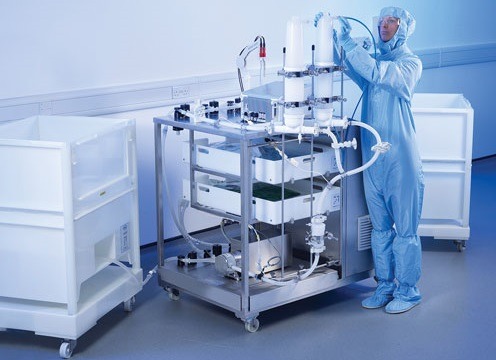#bioreactors
Text
Bioreactors Market Size, Share, Growth, Company Profiles, Types, End Users and Forecast by 2031
The Bioreactors Market, as analyzed by Metastat Insight, encompasses a wide array of industries and applications, ranging from pharmaceuticals to biotechnology and beyond. Bioreactors play a crucial role in these sectors by providing controlled environments for the cultivation of various biological organisms, such as cells, bacteria, and yeast, under optimal conditions for growth and production. These versatile devices serve as essential tools for research, development, and manufacturing processes, driving innovation and progress in numerous fields.
Get Free Sample Report @ https://www.metastatinsight.com/request-sample/2729
Top Companies
Pall Corporation, Merck Group, Thermo Fisher Scientific, Getinge (Applikon Biotechnology), Cellexus Ltd, Shanghai Bailun Biotechnology co., Sartorius Group Eppendorf AG, PBS Biotech, Eppendorf AG.
One of the primary drivers behind the growth of the Global Bioreactors market is the increasing demand for biopharmaceuticals and biotechnology products. With the rising prevalence of chronic diseases and the growing aging population worldwide, there is a growing need for advanced therapies and treatments. Bioreactors are indispensable in the production of biopharmaceuticals, including vaccines, monoclonal antibodies, and recombinant proteins, providing scalable and efficient platforms for their synthesis.
Moreover, the expanding applications of bioreactors beyond traditional pharmaceuticals are fueling market growth. Industries such as food and beverage, agriculture, and environmental science are increasingly utilizing bioreactors for various purposes, such as fermentation, biofuel production, and waste treatment. This diversification of applications broadens the market scope and creates new opportunities for bioreactor manufacturers and suppliers.
Browse Complete Report @ https://www.metastatinsight.com/report/bioreactors-market
Technological advancements are also driving innovation in the Global Bioreactors market, leading to the development of next-generation bioreactor systems with enhanced capabilities and performance. Integrated sensors, automated control systems, and advanced monitoring tools enable real-time process monitoring and optimization, improving efficiency, reproducibility, and product quality. Additionally, the integration of single-use bioreactors and continuous manufacturing technologies offers flexibility and cost-effectiveness, catering to the evolving needs of the industry.
0 notes
Text
Biotechnology Instruments: Enabling Life-Changing Advancements in Science and Medicine

As biotechnology continues to transform healthcare and advance scientific discovery, the instruments used in modern labs have become increasingly important. Precision laboratory equipment allows researchers to conduct intricate experiments, make accurate measurements, and gain new insights at the molecular level. With the aid of biotechnology instruments, scientists are driving innovation across diverse fields such as drug development, disease diagnosis, genetic engineering, agricultural biotechnologies, and more.
Gene Sequencing Devices Catalyzing Genomic Research
One type of instrument central to many areas of biotechnology is gene sequencing devices. These machines enable rapid DNA and RNA sequencing on a large scale. Next-generation sequencing technologies can now sequence an entire human genome within a single day for under $1,000, representing a dramatic decrease in cost and increase in speed compared to earlier methods. Gene sequencing devices are empowering wide-ranging genomic research, from investigating the genetic factors behind diseases to tracking the evolution of viruses and bacteria. They are also helping biotechnology companies develop personalized medicines tailored to a person’s unique genetic profile. Advanced gene sequencing will continue fueling major discoveries in biology, healthcare, and other fields for many years to come.
Polymerase Chain Reaction Machines Amplifying DNA Fragments
The polymerase chain reaction (PCR) machine is a fundamental tool for amplifying specific DNA fragments, useful in countless applications. Through repeated cycles of heating and cooling, PCR multiplies even tiny amounts of DNA, generating millions of copies that can then be analyzed. Whenever precise copying of DNA or RNA strands is needed, such as for gene sequencing, forensic analysis, medical diagnostics, and more, PCR devices play an invaluable role. New designs now offer faster amplification times, higher throughput, and other improvements. PCR’s importance to Biotechnology Instruments means ongoing instrumentation refinements will keep broadening its range of uses and capabilities.
Fermentors and Bioreactors Cultivating Cells and Microbes
In industrial biotechnology instruments and pharmaceutical manufacturing, large-scale fermentors and bioreactors are essential for growing cells, tissues, microbes, and other organisms in a controlled environment. These types of instruments can replicate conditions found inside the human body at an industrial size. This allows for mass production of valuable products like antibiotics, enzymes, biofuels, vaccines, and therapeutic proteins. Advancing bioreactor technologies with features like online monitoring and precise regulation are helping maximize yields. New single-use bioreactor systems also provide flexible, low-cost alternatives ideal for developing biotherapeutic processes. Continued instrumentation progress will help expand biomanufacturing capabilities.
Flow Cytometers Analyzing Individual Cells Rapidly
Flow cytometers are indispensable cell analysis instruments within biotechnology and medical research. By suspending cells in a fluid and passing them single-file through a laser beam, flow cytometers can rapidly quantify physical and biochemical characteristics like size, shape, internal complexity, and expression of specific proteins on tens of thousands of individual cells per second. This enables studies of cell populations, sorting cell subtypes, and more. New state-of-the-art flow cytometer designs deliver improved sensitivity and resolution, simplified operation through touchscreen interfaces, and greater flexibility. Their extensive usage spans studying blood disorders, screening for rare cell types, sorting stem cells for regenerative therapies, and furthering immunology research.
Microarrays Assessing Gene Expression Profiles
DNA microarrays, also known as gene or expression chips, simultaneously measure activity levels of tens of thousands of genes. By allowing rapid assessment of entire genomic expression profiles, microarrays accelerate discovery of biomarkers, disease subtypes, and gene functions. Industries from pharmaceuticals to agriculture leverage microarray insights. Advancements include next-gen RNA sequencing microarrays offering greater sensitivity, lower sample input, and custom designs tailored for specific model organisms. Further engineering aims to develop higher throughput and cost-effective microarrays suited for clinical diagnostics. Microarray instruments exemplify how biotechnology platforms can reveal how genes and pathways relate to specific biological states or conditions.
Bioprocess Analyzers Monitoring Fermentation Parameters
Ensuring optimal control of cellular growth and product formation demands constant monitoring through bioprocess analyzers. These instruments measure key in-line parameters like pH, temperature, cell density, sugar and metabolite levels during fermentations. Real-time feedback allows operators to precisely modulate conditions. New analyzers provide expedited multi-parameter analysis, simplified calibrations, and continuous monitoring capabilities critical to maximizing process efficiency and yields. Cloud-based software enables remote data access. As biotechnology instruments scales up, automated bioprocess analyzers will play an increasingly strategic role in quality assurance and meeting regulatory requirements. Their evolution exemplifies how instrumentation progress enables improved bioprocesses.
Confocal Microscopes Viewing Three-Dimensional Structures
Confocal laser scanning microscopes excel at optically sectioning specimens to generate high-resolution three-dimensional images, distinguishing structures just nanometers apart. Equipped with fluorescent dyes, confocal microscopes vividly render cellular components, tissues and organisms. Their non-destructive sampling makes them valuable in fields as diverse as developmental biology, neuroscience, plant science and cancer research. New multiphoton confocal microscopes even penetrate deeper tissues. Alongside enhancements like higher speeds, additional detection channels and Intelligent Imaging, confocal microscopy opens new avenues for understanding cell and organ functions at subcellular resolution in 3D. Their growing use demonstrates biotechnology’s dependence on advanced optical tools.
Overall, as biotechnology instruments innovation remains crucial to achieving its full potential. Continued evolution of established platforms and emerging techniques will push the boundaries of molecular discovery and accelerate progress in medicine, agriculture and more industries. Precision laboratory tools, combined with expanding genomic and molecular data, allow addressing vital challenges through innovative biotechnological solutions. Their rising centrality shows why instrumentation represents a crucial frontier for the biotechnology field as a whole.
Get more insights on Biotechnology Instruments
About Author:
Money Singh is a seasoned content writer with over four years of experience in the market research sector. Her expertise spans various industries, including food and beverages, biotechnology, chemical and materials, defense and aerospace, consumer goods, etc. (https://www.linkedin.com/in/money-singh-590844163)
#BiotechnologyInstruments#LabEquipment#Bioreactors#Centrifuges#ChromatographySystems#DNASequencers#ElectrophoresisEquipment#FlowCytometers#MassSpectrometers
0 notes
Text

The Bioprocessing Summit 2024
https://expopeak.com/event/the-bioprocessing-summit-2024/
#Accelerating#Analytical#Bioprocessing#And#Bioengineering#Equipment#Materials#Services#bioprocessing#regulatory#BioProduction#Scale#Bioreactors#Disposals#Opt#Cell#Line#Culture#Therapy#CMC#Analytics#Manufacturing#Continuous#Processing#Digital#Transformation#AI#Venture#Downstream#Process
0 notes
Text
Can a Company Transform The Coffee Industry Using Biotechnology?
0 notes
Text
Single-Use Bioprocessing Market in the Quest for Efficient Biopharmaceutical Production
The global single-use bioprocessing market size is projected to reach USD 80.13 million by 2030, registering a compound annual growth rate (CAGR) of 16.24% over the forecast period, according to a new report by Grand View Research, Inc. The demand for single-use bioprocessing offerings is driven by the commercial advantages offered, including a reduction in costs and time required for bioprocessing operations. Originally used for monoclonal antibody production, single-use technologies are also gaining traction for cell and gene therapy manufacturing. As a result, broadening the scope of applications in biomanufacturing operations is likely to drive industry growth.

Single-use Bioprocessing Market Report Highlights
The simple & peripheral elements segment held the largest share in 2023 due to the significant adoption of these products as a result of a variety of customizable options available for bioprocessing applications
The upstream bioprocessing workflow segment accounted for the largest share in 2023. Continuous developments and betterment in technologies for upstream bioprocessing are driving the segment growth
North America was the leading region in 2023 due to the high R&D spending and growth of the biopharmaceutical manufacturing sector in the region
Furthermore, the presence of key players, such as Thermo Fisher Scientific, Inc. and Danaher Corp., is driving the regional market
The biopharmaceutical manufacturers end-use segment dominated the industry in 2023 and accounted for the maximum revenue share. This was due to the high demand for biologics and heavy investments in cell & gene therapy manufacturing
For More Details or Sample Copy please visit link @: Single-use Bioprocessing Market Report
Furthermore, strategic initiatives from key players are expanding the industry's growth prospects. For instance, in July 2021, Cytiva and Pall Corp. announced investment plans for capacity expansion over two years. Among other key products, more than USD 300 million were invested in single-use technologies, such as bioreactor bags for cell expansion, used to make personalized therapies and syringe filters for scientific research. Similarly, the growing adoption of single-use equipment for in-house and contract manufacturing has opened new avenues for the flow of investments in this space. The industry is witnessing significant advancements in several product portfolios, including disposable probes and sensors, stirring systems, bioreactor designs, and filtration technologies, which are expected to contribute to strong revenue growth.
The benefits offered by single-use bioprocessing systems have enabled biopharmaceutical manufacturers to offer their products faster to the market by introducing multi-product facilities, entering into partnerships, or outsourcing pipeline products for contract development and manufacturing. For instance, in January 2021, Sartorius AG partnered with RoosterBio, a leading supplier of human Mesenchymal Stem/Stromal Cells (hMSC). This collaboration aimed at advancing cell & gene therapy manufacturing by leveraging the single-use manufacturing technologies from Sartorius AG. The COVID-19 pandemic has generated new growth opportunities for key stakeholders in the industry.
#Single-Use Bioprocessing#Biomanufacturing#Bioprocessing Technology#Biopharmaceuticals#Disposable Technology#Sustainable Bioprocessing#Flexible Manufacturing#Bioproduction#BioProcess Containers#Bioreactors#Downstream Processing
0 notes
Text

𝐆𝐞𝐧𝐨𝐦𝐞 𝐄𝐝𝐢𝐭𝐢𝐧𝐠 𝐚𝐧𝐝 𝐂𝐑𝐈𝐒𝐏𝐑 𝐓𝐞𝐜𝐡𝐧𝐨𝐥𝐨𝐠𝐲: The development of the CRISPR-Cas9 system has revolutionized #geneticengineering and gene editing. Researchers are using this technology to modify genes in organisms
𝐒𝐲𝐧𝐭𝐡𝐞𝐭𝐢𝐜 𝐁𝐢𝐨𝐥𝐨𝐠𝐲: #syntheticbiology involves designing and constructing biological systems or organisms with novel functions or capabilities. This field has led to the creation of synthetic microbes for various applications
Visit @ https://symbiosisonlinepublishing.com/biotechnology/
#biotechnology#biology#environmentalbiotechnology#Bioreactors#immunobiotechnology#nanobiotechnology#AgriculturalBiotechnology#agricultural#MolecularGenetics#Therapeutics#stemcellresearch#journals#journal#pubmed#peerreview#OpenAccess#openaccessjournal#symbiosisonlinepublishing
0 notes
Text

Roch Bio: Cultivating Green Miracles, One Microbe at a Time - Revolutionizing Sustainable Agriculture!
Visit Here For More Info:- https://bit.ly/3qwcCFi
#RochBioFertilizerReactor #SustainableAgriTech #EcoFertilizer #BioReactors #GreenFarming #InnovativeAgriTech #FertilizerRevolution #AgriSolutions #EcoFriendlyFarm #BioFertilizerTech
#RochBioFertilizerReactor#SustainableAgriTech#EcoFertilizer#BioReactors#GreenFarming#InnovativeAgriTech#FertilizerRevolution#AgriSolutions#EcoFriendlyFarm#BioFertilizerTech
0 notes
Text
Bioreactors
Fluid BioSolutions: Your partner for advanced bioreactors. Elevate your bioprocessing with our cutting-edge solutions. Explore our bioreactor technologies now!
0 notes
Text
The Advantages of Stainless-Steel Fermenters
Introduction:
In the world of brewing, the choice of equipment plays a crucial role in achieving optimal results. Stainless steel (SS) fermenters have gained immense popularity among brewers for their exceptional performance and numerous benefits. In this blog, we will explore the advantages of using stainless steel fermenters, focusing on how they elevate brewing quality and efficiency. Join us as we uncover the reasons why stainless steel has become the preferred material for fermenter construction in the brewing industry.
Superior Hygiene and Cleanliness:
One of the primary benefits of stainless-steel fermenters is their excellent hygiene and cleanliness properties. Stainless steel is non-porous, preventing bacteria, contaminants, and odors from being absorbed into the material. This feature ensures a sanitary brewing environment, minimizing the risk of off-flavors and contamination.
Durability and Longevity:
Stainless steel fermenters are renowned for their exceptional durability and longevity. They are highly resistant to corrosion, rust, and staining, making them suitable for long-term use in challenging brewing conditions. The robustness of stainless steel ensures that fermenters can withstand rigorous cleaning, handling, and temperature variations without compromising their structural integrity.
Thermal Stability and Temperature Control:
Stainless steel exhibits excellent thermal conductivity, allowing for precise temperature control during fermentation. Fermenters made from stainless steel can effectively maintain desired fermentation temperatures, crucial for achieving consistent and high-quality brews. The ability to control temperature variations ensures optimal yeast activity, flavor development, and attenuation.
Easy Cleaning and Maintenance:
Stainless steel fermenters are designed with ease of cleaning and maintenance in mind. Their smooth surfaces and non-reactive nature facilitate straightforward cleaning procedures, minimizing the risk of residual flavors or contaminants. Stainless steel is also resistant to chemical agents commonly used in cleaning and sanitization, ensuring long-lasting hygiene and ease of maintenance.
Versatility and Flexibility:
Stainless steel fermenters offer versatility and flexibility to accommodate various brewing styles and volumes. They come in a range of sizes, from small-scale homebrewing to large commercial operations, catering to diverse brewing needs. Stainless steel fermenters can be customized with additional features like pressure relief valves, sampling ports, and integrated cooling jackets to further enhance brewing control and flexibility.
Aesthetic Appeal:
Apart from their functional advantages, SS fermenters also provide an aesthetic appeal. Their sleek and professional appearance adds a touch of elegance to brewing spaces, creating a visually appealing environment for brewers and visitors alike. Stainless steel's timeless and polished look reflects the dedication and professionalism of the brewing craft.
Conclusion: Stainless steel fermenters offer a myriad of benefits that significantly enhance brewing quality and efficiency. From superior hygiene and durability to precise temperature control and easy maintenance, the advantages of stainless steel in fermentation equipment are undeniable. Whether you are a homebrewer or operating a commercial brewery, investing in stainless steel fermenters can elevate your brewing process, ensuring consistent, high-quality brews and contributing to an overall exceptional brewing experience. Embrace the benefits of stainless steel and unlock the full potential of your brewing endeavors.
0 notes
Link
0 notes
Text
Bioreactors Market Size is expected to reach US$ 5,169.01 Mn by 2027
The global Bioreactors Market is segmented based on deployment, component, solution, application, and geography. The segmentation in this research study has been finalized post in-depth secondary research and extensive primary research. In addition, the market is also segmented on the basis of products offered by the leading participants in the industry in order to understand widely used market specific terminologies. Thus, we have incorporated the segments of the research and have finalized the market segmentation.
The bioreactors market is highly competitive in nature with considerable number of players, having a high level of consolidation overall revenue share. Most of the companies operating in the bioreactors market are present globally and have wide distribution and sales network through partnerships or authorized dealers.
The report segments the global Bioreactors Market based on application, type, service, technology, and region. Each chapter under this segmentation allows readers to grasp the nitty-gritty of the market. A magnified look at the segment-based analysis is aimed at giving the readers a closer look at the opportunities and threats in the market. It also addresses political scenarios that are expected to impact the market in both small and big ways. The report on the global Bioreactors Market examines changing regulatory scenarios to make accurate projections about potential investments. It also evaluates the risk for new entrants and the intensity of the competitive rivalry.
Get PDF Sample Copy @ https://www.theinsightpartners.com/sample/TIPHE100000880/
0 notes
Text



More drawings while I play with new inks.
#suggestive#not worth tagging lol#inks for the ink-curious are salted seabreeze/voltaic arc then bioreactor/emerald fusion and lastly blossomed lotus/diamine scarlet#scarlet and voltaic arc are not new to me they just went well for details#going back to digital soon so's I have the almighty crtl-z back in my power bc freehanding ink with a hand tremor is kinda stressful lol#I have a retrospective thing I wanna finish before the year's out but SHINY NEW THING brain is hard to overcome#is the last week before nye even real?#i think not#inking things
78 notes
·
View notes
Text
The Bioprocessing Summit 2024
Unleash Bioprocessing Innovation at The Bioprocessing Summit 2024
Discover the future of biopharmaceutical manufacturing at The Bioprocessing Summit 2024. Find event details and more on ExpoPeak.
#Accelerating#Analytical#Bioprocessing#And#Bioengineering#Equipment#Materials#Services#bioprocessing#regulatory#BioProduction#Scale#Bioreactors#Disposals#Opt#Cell#Line#Culture#Therapy#CMC#Analytics#Manufacturing#Continuous#Processing#Digital#Transformation#AI#Venture#Downstream#Process
0 notes
Text
I'm in Baby's First Management Role and i am having Baby's First Management Role Problems
I don't have time to write or send important messages because everyone needs my help all the time and my improv "yes, and" training is biting me in the ass like a bunch of piranhas in a spy movie
#we have enough stations and bioreactors to take down Thursday morning and set up Thursday afternoon#but not enough base bottles and vent traps! Shm!!!! how could you do this!!!!!!!!!
42 notes
·
View notes
Text
subanutica is good
just wish i had the actual room…
#subnautica#blue plays subnautica#I assume i just. go directions and hopefully i find it#i have the moonpool :/#but i don’t think i can put a bioreactor in there…#to be perfectly clear i am talking about the multipurpose room#if someone could poke me in vaguely the right direction-#i just want to know; i AM supposed to have that by now; right?
10 notes
·
View notes